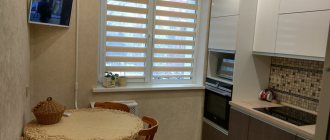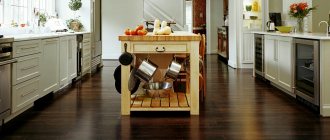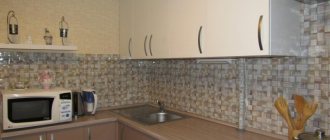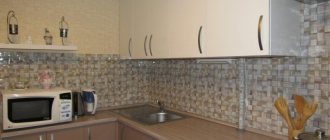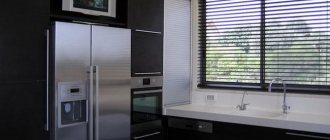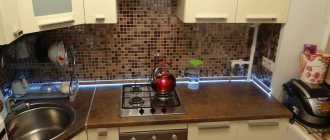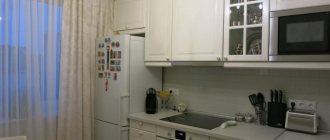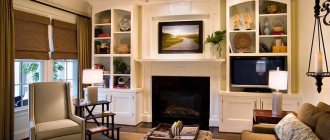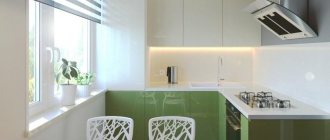The kitchen is where we spend most of our time. Not everyone has the opportunity to arrange a separate dining room - so breakfast, lunch and dinner are held in the kitchen.
A TV in the kitchen has long ceased to be a luxury or something special - it is a necessity and part of the leisure time of most family members. To highlight a TV area in the kitchen, you need to take into account the specifics of the room and many other details - details and tips in this article.
Choosing a TV for the kitchen
Choosing a kitchen TV has some subtleties that are definitely worth considering:
- body thickness;
- size (diagonal);
- viewing angle;
- design;
- functionality.
The thickness of the case must be selected based on the mounting location. For example, if the TV will be placed above the table, it should be as thin as possible.
The viewing angle is an important nuance specifically for a kitchen TV. In the kitchen you have to watch TV from different angles, and viewing from any side should be comfortable and convenient.
The design is selected to match the kitchen set or the entire kitchen design. This is an optional aspect when choosing, but the aesthetic side still plays an important role when choosing.
Functionality is determined by the individual wishes of users. You can purchase a regular one with a small set of necessary options or an ultra-fashionable functional copy.
Types
Liquid crystal
Liquid crystal displays, which are famous for their reliability and low price, are not always suitable for the kitchen. The reason is the peculiarity of the matrix. A clear picture can only be seen from a certain angle, and from other points the viewing angle will be lost and the image will begin to distort.
Of all the types, with a limited budget, this is the best option in terms of price-quality ratio.
Plasma
By purchasing a plasma model, you will get an excellent picture that will not be refracted. But LED screens have a number of significant disadvantages. Their cost is high, durability is low, weight is high, and hanging it on the wall is problematic, and the opposite part gets very hot. More suitable for kitchen-living room.
Special types are also produced, for example, equipped with a sealed housing that will protect its microcircuits from moisture and high temperatures. They can be placed above the stove or above the sink.
Built-in models
The built-in TV is compactly installed in a cabinet or pencil case. It is equipped with a cooling system, due to which the back wall does not heat up without air circulation. Such equipment is several times more expensive than conventional analogues.
The built-in TV fits perfectly into the interior without disturbing the style.
Choosing a place in the kitchen: what to consider
Choosing a place in the kitchen to place the TV is a crucial step. The specifics of the kitchen space include temperature changes due to cooking, splashes of water from the kitchen sink, bright lighting, small space and many other factors that are worth considering.
Placement height . You must try to place the TV so that when viewing the picture on the screen does not look distorted. It is definitely worth taking into account viewing features - who, when and how often uses the device in the kitchen, and based on this, calculate the height.
Temperature . The TV should be located as far as possible from the stove - high temperatures are destructive even for the most durable model.
Viewing angle . Consider the angles along with the height - this will create the most comfortable viewing conditions.
Water . Water is destructive for such household appliances. Therefore, the TV must be placed as far as possible from the kitchen sink.
You can't do that
Bright lighting . Most often, the kitchen has bright lighting, but it is comfortable to watch TV in the twilight. This nuance should definitely be taken into account when choosing a location.
Hygiene issue
No one will deny that the kitchen is a place with a high degree of pollution. Steam, greasy splashes, water... All this cannot but affect the longevity of the TV.
You will have to carefully consider the placement of your TV to prevent premature failure.
In addition to the placement recommendations already given, there is another way to solve this problem - a protective screen. Of course, for a TV simply placed on a shelf, this method is not feasible.
However, if you decide to build the equipment into a niche or place it on a special shelf, perhaps this decision will help you significantly extend the life of the TV.
The transparent screen is attached to the edges of the niche or the sides of the shelf. You can use durable glass or plastic for it - such materials do not interfere with the operation of the remote control, but will reliably protect the TV from dirt, grease and dust.
Another option has a more decorative function - sliding doors that will help hide the TV when you are not using it. If you choose a material that matches the kitchen set, no one will guess that there is a TV in the kitchen when the door is closed.
Alternatively, you can use contrasting colors - an interesting and not yet banal design technique.
Successful options for placing a TV in the kitchen
How to choose the most convenient and functional place to place the TV in the kitchen? There is no single answer to this question - everyone decides individually for themselves, and there are quite a lot of options for successful placement.
Integrate into kitchen set
TVs built into kitchen units represent know-how and modern technologies that only recently seemed like science fiction.
Built-in models are LCD TVs with a glass mirror screen and a metal body. It is these varieties that are not afraid of moisture, high temperature, dust and stains - they can also be placed in a cabinet near the stove or sink.
The devices can be built in next to the microwave in the upper kitchen cabinets, creating interesting design solutions.
Above the kitchen table
This solution is convenient and practical, but you need to take into account some subtleties:
Height . The TV should be at eye level of those sitting at the table - this is the most comfortable location.
Diagonal . The size of the TV should not be large, especially if the kitchen and table are small.
Slim mount . You should not choose a massive bracket - this solution is not suitable for watching TV shows at the table. The mount should be flat and small, and the TV should be as close to the wall as possible.
In the corner of the kitchen
A convenient option, ideal for small spaces. You can choose an angle from which there will be a comfortable view for both those sitting at the table and those standing at the stove.
Above the door
High placement is suitable for those who spend most of their time standing in the kitchen.
It is worth considering that the height should still be calculated based on eye level - watching TV shows or movies with your head held high is uncomfortable, especially if you have to do kitchen work while watching TV.
A swivel multifunctional bracket is a must here - you also need to take into account those sitting at the table. If the TV is mounted too high and without the ability to adjust its position, viewing will be uncomfortable.
In a niche
One of the most successful design solutions is a niche for a TV. It is most convenient if the niche was initially provided for during construction - this is a ready-made zoning; all that remains is to select the dimensions of the device and provide a TV output and electrics. You can make a kind of TV area yourself - modern designers love such options.
The main nuance of this choice is the size of the room. If the kitchen is small, you shouldn’t design a niche that will take up part of the space; it’s better to use a bracket.
On the shelf
If the TV is not too heavy and small, it can be installed on a shelf. Suitable for both separately attached and open kitchen shelves.
It is important to observe some points:
- TV weight;
- fastening strength and shelf thickness;
- the need to rotate and tilt the TV.
Keep in mind that the device standing on a shelf cannot be tilted down, and maneuverability is limited for turning to the sides. The shelf should be located as conveniently as possible in relation to the eye level of those who will most often use the TV.
On the tabletop
A convenient, practical and economical option is a countertop - there is no need for zoning, making special kitchen cabinets or installing brackets.
But there is one significant drawback - limited space. The countertop is where food and drinks are prepared, every centimeter is almost always used. And the TV will take up quite a lot of space and be capricious in relation to the proximity of the stove and faucet.
Or maybe from below?
An unusual design technique is to place the TV almost at floor level. This makes the TV look unusual and attracts attention.
If you purchased a kitchen island (a table with shelves that is not placed near a wall), try building a TV there. Of course, watching it will not be entirely convenient. However, if you love music channels and at the same time want to shock your guests, this method will be justified.
Placing TV in a small kitchen
A small TV is suitable for a small kitchen. And be sure to take into account the optimal distance from the screen to the eyes.
For example, TVs with a diagonal of 15–20 inches can be viewed at a distance of 1.5 meters, and 25 inches and larger - 2.5 meters. Accordingly, for Khrushchev’s kitchens it is recommended to purchase devices with a diagonal of no more than 20 inches.
The most suitable TV placement options for small kitchens:
- in the corner on a bracket;
- built into the kitchen set;
- above the door;
- on the windowsill;
- on the shelf.
Each decision is individual. In this case, it is necessary to focus not only on the size of the kitchen, but also on the layout, placement of the table and cabinets, location of the stove and sink.
A TV in the kitchen is part of the interior, a source of news and good mood. Proper placement of TV in the kitchen area will help you enjoy watching it at any time.
We use swivel brackets
This is the easiest and most accessible way for many. Attach the TV to a free wall using anchor bolts. This design is easy to install and allows you to change the position and angle of inclination depending on your needs. Moreover, the bracket is invisible behind the TV, so you don’t have to worry about the appearance of the wall.
This option is perfect for small spaces and will save space for placing other useful things, such as a microwave or coffee maker.
Photo: accesoalanube.com
Photo: decorpad.com
TV in the kitchen real photo examples
Results
The kitchen is one of the important and frequently visited rooms in any home. Everything here should be useful and beautiful. Most people want to put a TV in this place, and select the optimal placement for it.
If the TV will be used only by the housewife who wants to be distracted by it while cooking, then the equipment should be installed at a high height and can even be above the dining area, near the chairs and table.
This will suit any size room. So, on an area of 15 square meters you can place a straight set in a cream shade, a round glass table and tall beige chairs with dark legs. You can hang a medium-sized TV above the chairs. Large kitchens with tiered white ceilings and hardwood floors can accommodate a wide TV above the countertop.
Risk factors during operation
Despite the fact that kitchen televisions have increased resistance to a wide range of destructive factors, they can still fail over time under the influence.
- Vibrations constantly created by blenders, mixers, electric meat grinders, coffee makers, kitchen machines and food processors;
- Vapors, dampness, caustic food fumes constantly hanging in the air;
- Strong temperature fluctuations.
Close-up viewing
You can fully enjoy such a small picture only by moving close to the screen. This can be done, for example, during a light dinner served on a buffet table on wheels. Along with the table, you will have to move the soft banquette.
In addition to the miniature size of the screen, a significant disadvantage of the initially built-in TV is its much higher cost.
